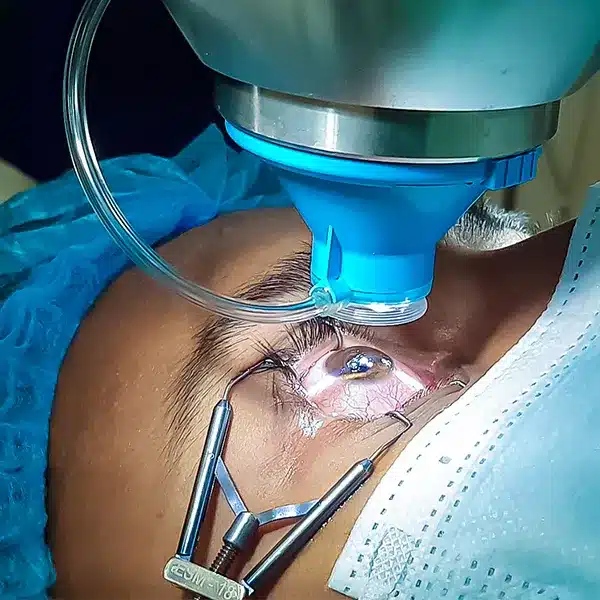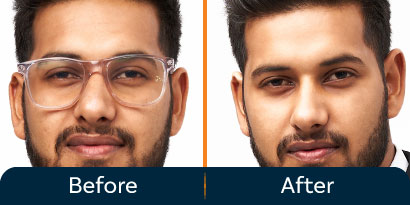Table of Contents

Laser Eye Surgery in Turkey: How Much is Gastric Sleeve Surgery? Discover Benefits, Costs, and More!
Vision problems affect millions worldwide, with glasses and contact lenses being the go-to solutions for most people. However, laser eye surgery has revolutionized vision correction by providing a permanent, effective, and safe alternative.
One country leading the way in affordable and high-quality laser eye surgery is Turkey. Thousands of patients from around the world, especially from Europe, the UK, the USA, and the Middle East, travel to Turkey each year for this procedure. But what makes laser eye surgery in Turkey such a popular choice?
By the end of this guide, you’ll have all the information needed to make an informed decision about whether Turkey is the right destination for your laser eye surgery.
Time in Turkey
7 to 14 days
Surgery Time
2 to 5 hours
Hospital Stay
1 to 3 days
Recovery
2 to 6 weeks
Accomodation
4/5* Hotels
Transportation
Private Driver
What is Laser Eye Surgery in Turkey?
Laser eye surgery in Turkey is a popular and affordable option for those seeking to correct vision problems such as nearsightedness (myopia), farsightedness (hyperopia), and astigmatism. The procedure, which typically includes options like LASIK (Laser-Assisted In Situ Keratomileusis), PRK (Photorefractive Keratectomy), and other advanced laser treatments, is widely available at various clinics and hospitals across the country.
Types of Laser Eye Surgery
There are multiple types of laser eye surgery, each designed to treat specific vision problems. These procedures use advanced technology to reshape the cornea, the clear front surface of the eye, to improve how light enters the eye and, ultimately, enhance vision. The most common types of laser eye surgeries are LASIK, PRK, SMILE, and LASEK, and each has its own advantages depending on the patient’s specific condition. Here’s an expanded look at these different types of laser eye surgery:
▪ LASIK (Laser-Assisted in Situ Keratomileusis)
▪ Most common and widely performed procedure
▪ A thin corneal flap is created and reshaped with a laser
▪ Quick recovery (1–2 days)
▪ Minimal discomfort
▪ PRK (Photorefractive Keratectomy)
▪ No corneal flap is created; instead, the outer corneal layer is removed
▪ Longer recovery time (1–2 weeks)
▪ Suitable for thin corneas and active individuals (e.g., athletes)
▪ LASEK (Laser Epithelial Keratomileusis)
▪ A hybrid of LASIK and PRK
▪ Less painful than PRK but longer recovery than LASIK
▪ Best for patients with dry eyes or thin corneas
▪ SMILE (Small Incision Lenticule Extraction)
▪ The most advanced and minimally invasive laser surgery
▪ Less dry eye risk compared to LASIK
▪ Recommended for high myopia patients
How Is the Laser Eye Surgery Procedure Done
Laser eye surgery is a quick and effective procedure used to correct vision problems such as nearsightedness (myopia), farsightedness (hyperopia), and astigmatism. The most common types include LASIK, SMILE, and PRK. Here’s how the procedure is done:
1. Pre-Surgery Preparation
■ The patient undergoes a detailed eye exam, including corneal thickness measurements and vision tests.
■ The doctor determines the best laser technique based on eye structure and prescription.
■ Numbing eye drops are applied to ensure a painless procedure.
■ The patient is positioned under the laser machine, and a lid speculum is used to keep the eye open.
2. Creating the Corneal Flap (For LASIK Only)
■ A femtosecond laser or microkeratome is used to create a thin flap in the cornea.
■ The flap is lifted to expose the underlying corneal tissue.
3. Reshaping the Cornea with a Laser
■ An excimer laser precisely reshapes the cornea by removing microscopic layers of tissue.
■ This adjustment corrects how light enters the eye, improving vision.
■ The process takes only a few seconds per eye, depending on the correction needed.
4. Flap Repositioning (For LASIK Only)
■ The corneal flap is carefully repositioned, and it naturally adheres without stitches.
5. Recovery & Post-Surgery Care
■ The patient rests for a short time before being allowed to leave.
■ Blurry vision and mild discomfort are common for a few hours but improve quickly.
■ Prescribed eye drops help prevent infection and dryness.
■ Most patients notice significant vision improvement within 24 hours.
6. Follow-Up Appointments
■ A check-up the next day ensures proper healing.
■ Patients must avoid rubbing their eyes, swimming, and heavy activities for a few weeks.
■ Full recovery takes about 1-4 weeks, depending on the procedure type.
Why is Turkey a Popular Destination for Laser Eye Surgery?
Turkey has become one of the leading destinations for laser eye surgery, attracting patients from all over the world. Known for its high-quality healthcare, advanced medical technology, and experienced surgeons, Turkey offers a combination of affordability and excellence that makes it an appealing choice for those seeking vision correction. The country’s growing reputation in medical tourism, particularly in the field of laser eye surgery, is also fueled by its modern clinics, international accreditation, and the opportunity for patients to combine treatment with a visit to its rich cultural and historical landmarks. As a result, Turkey continues to be a top choice for those looking to improve their vision without breaking the bank.
▪ Affordable Prices
▪ Turkey offers laser eye surgery at a fraction of the cost compared to countries like the USA, UK, and Germany.
▪ Highly Experienced Surgeons
▪ Many Turkish ophthalmologists are trained internationally, holding certifications from Europe and the USA.
▪ State-of-the-Art Technology
▪ Turkish clinics use cutting-edge laser technology, such as:
▪ Femtosecond LASIK
▪ Wavefront-guided LASIK
▪ Topography-guided laser surgery
▪ Short Waiting Times
▪ Unlike in the UK and Canada, where patients wait months, laser eye surgery in Turkey can be scheduled within days.
▪ All-Inclusive Medical Tourism Packages
▪ Most clinics offer comprehensive packages, including:
▪ Pre-operative tests
▪ VIP transportation
▪ 5-star hotel accommodation
▪ Post-surgery check-ups
Befor & After Laser Eye Surgery in Turkey




Cost of Laser Eye Surgery in Turkey vs. Other Countries
Laser eye surgery has become a popular and effective solution for individuals seeking to correct vision problems such as nearsightedness, farsightedness, and astigmatism. With advancements in technology, procedures like LASIK and other laser eye surgeries offer patients a chance to reduce or eliminate their dependence on glasses or contact lenses. However, the cost of laser eye surgery can vary greatly depending on the country, clinic, and specific treatment used. In Turkey, the cost of laser eye surgery is generally more affordable compared to many Western countries, making it a popular destination for medical tourism. In contrast, the price of laser eye surgery in countries like the United States, the United Kingdom, and other European nations can be significantly higher. This comparison of laser eye surgery costs, including LASIK laser eye surgery prices and average surgery fees, will help patients understand the financial differences and make an informed decision based on both quality and affordability.
Country | LASIK Cost (Per Eye) | PRK Cost (Per Eye) | SMILE Cost (Per Eye) |
Turkey | $1,000 – $2,500 | $800 – $1,500 | $1,500 – $2,800 |
USA | $2,500 – $4,500 | $2,000 – $3,500 | $3,500 – $5,000 |
UK | £2,000 – £3,500 | £1,800 – £3,200 | £3,000 – £4,500 |
Canada | CAD $2,500 – CAD $4,500 | CAD $2,000 – CAD $3,800 | CAD $3,500 – CAD $5,000 |
Germany | €2,000 – €4,000 | €1,800 – €3,500 | €3,200 – €5,000 |
India | $700 – $1,500 | $500 – $1,200 | $1,200 – $2,000 |
How to Choose the Right Clinic and Surgeon in Turkey
Choosing the right clinic and surgeon is one of the most crucial steps when considering laser eye surgery, especially if you’re traveling abroad. A highly skilled and experienced surgeon significantly reduces the risk of complications and ensures the best results. While Turkey is a top destination for affordable and high-quality medical tourism, not all clinics maintain the same standards—making careful research essential.
What to Look for in a Laser Eye Surgery Clinic
▪ Reputation and Reviews
▪ Look for patient testimonials on trusted platforms like Google Reviews, Trustpilot, and medical forums.
▪ Check if past international patients, especially from your country, recommend the clinic.
▪ Surgeon’s Qualifications and Experience
▪ Choose a board-certified surgeon with years of experience in procedures like LASIK, PRK, and SMILE.
▪ Ask about their success rate and the number of surgeries they’ve performed.
▪ Technology and Equipment Used
▪ Ensure the clinic uses modern technology like:
▪ Wavefront-guided LASIK
▪ Femtosecond laser
▪ SMILE technology
▪ Avoid clinics with outdated or non-FDA-approved equipment.
▪ Accreditation and Certification
▪ Look for ISO-certified clinics with international medical board accreditation.
▪ Check affiliations with:
▪ Turkish Ministry of Health
▪ European Society of Cataract and Refractive Surgeons (ESCRS)
▪ American Society of Cataract and Refractive Surgery (ASCRS)
▪ Pre-Surgery Consultation and Eye Examination
▪ A quality clinic offers a thorough pre-operative assessment.
▪ Avoid places that rush the evaluation or pressure you into surgery.
▪ Post-Surgery Care and Follow-Ups
▪ Ensure detailed aftercare instructions and scheduled follow-ups are provided.
▪ Some clinics offer virtual follow-ups once you return home.
▪ Pricing and Transparency
▪ Confirm all costs upfront—including exams, medication, and aftercare.
▪ Be cautious of extremely low prices, as they may signal lower standards or hidden fees.
Questions to Ask Your Surgeon Before the Procedure
About the Surgeon’s Experience
▪ How many laser eye surgeries have you performed?
▪ What is your success rate with LASIK/PRK/SMILE?
▪ Are you a board-certified ophthalmologist?
About the Procedure
▪ What type of laser surgery is best for my condition?
▪ How does the surgery work, step by step?
▪ Will both eyes be treated on the same day or separately?
▪ What kind of anesthesia will be used?
About Risks and Expectations
▪ What are the possible risks and complications?
▪ How long will the healing process take?
▪ Will my vision be clear right after surgery?
▪ Could I need a follow-up procedure?
About Post-Surgery Care
▪ What should I do before and after surgery for the best recovery?
▪ How soon can I return to work, exercise, or travel?
▪ What happens if I experience complications or vision changes?
About Pricing and Insurance
▪ What is the total cost of the surgery, and what’s included?
▪ Are there extra fees for consultations, medication, or follow-ups?
▪ Do you offer payment plans or financing?
▪ Is the procedure covered by insurance, and can you help with paperwork?
How to Book Laser Eye Surgery in Turkey
Booking laser eye surgery in Turkey is a simple process. Follow these steps to ensure a smooth experience:
1. Research & Choose a Clinic
■ Look for reputable eye clinics in Turkey with high success rates and positive reviews.
■ Check if the clinic is accredited and uses the latest laser technology (e.g., LASIK, SMILE, PRK).
■ Compare pricing, services, and patient care, including pre-op and post-op consultations.
2. Contact the Clinic for a Consultation
■ Most clinics offer free online consultations via video call or email.
■ Provide details about your eye health, prescription, and any previous eye conditions.
■ The doctor will assess if you are a good candidate for laser eye surgery.
3. Confirm Your Treatment Plan & Cost
■ Discuss the total cost, including pre-surgery tests, laser procedure, medications, and follow-ups.
■ Ask about payment options, discounts, and refund policies.
■ Some clinics offer all-inclusive packages that include accommodation and airport transfers.
4. Plan Your Travel & Accommodation
■ Book your flight to Turkey (Istanbul, Ankara, or Antalya are popular destinations for eye surgery).
■ Many clinics offer hotel stays or assist in arranging accommodation near the clinic.
■ Check visa requirements for your country.
5. Arrive & Undergo Pre-Surgery Tests
■ Upon arrival, visit the clinic for detailed eye exams and corneal mapping.
■ The doctor will confirm your suitability for the procedure and explain the surgery process.
6. Undergo the Laser Eye Surgery
■ The surgery is quick (usually 10-15 minutes per eye) and is performed under local anesthesia (eye drops).
■ Most patients experience immediate vision improvement after the procedure.
■ No overnight stay is required – you can return to your hotel the same day.
7. Post-Surgery Care & Follow-Up
■ Follow the clinic’s aftercare instructions, including using prescribed eye drops.
■ Avoid swimming, rubbing your eyes, and heavy activities for a few weeks.
■ A follow-up check-up is usually scheduled the next day before you return home.
■ Some clinics provide remote consultations for post-surgery follow-ups.
How Is the Laser Eye Surgery Procedure Done?
Laser eye surgery is a quick and effective procedure that corrects vision problems like nearsightedness, farsightedness, and astigmatism. The most common types of laser eye surgery include LASIK (Laser-Assisted In Situ Keratomileusis) and PRK (Photorefractive Keratectomy). Here’s a step-by-step breakdown of the LASIK procedure:
Pre-Surgery Preparation
▪ The surgeon performs a thorough eye examination to ensure suitability.
▪ Special anesthetic eye drops numb the eyes to prevent discomfort.
▪ A device keeps the eyelids open to prevent blinking during the procedure.
Creating the Corneal Flap
▪ A thin flap is created on the cornea using a femtosecond laser or microkeratome blade.
▪ The flap is lifted to expose the underlying corneal tissue.
Reshaping the Cornea with Laser
▪ A precise excimer laser reshapes the cornea by removing tiny amounts of tissue.
▪ The laser is guided by advanced computer technology for accuracy.
▪ This correction improves how light enters the eye, enhancing vision.
Repositioning the Flap
▪ The corneal flap is gently placed back into position.
▪ No stitches are needed as the flap naturally adheres to the cornea.
Post-Surgery Recovery
▪ The entire procedure takes about 10–15 minutes per eye.
▪ Patients may experience mild discomfort, light sensitivity, or blurry vision for a few hours.
▪ Vision usually improves within 24 hours, with full recovery in a few weeks.
▪ Follow-up appointments are necessary to monitor healing.
Alternative Laser Eye Surgeries
▪ PRK (Photorefractive Keratectomy): Instead of creating a flap, the outer corneal layer is removed, and the laser reshapes the cornea—ideal for patients with thin corneas.
▪ SMILE (Small Incision Lenticule Extraction): A modern, minimally invasive procedure where a small piece of corneal tissue is removed without creating a flap.
Benefits of Laser Eye Surgery
Laser eye surgery is a life-changing procedure that offers numerous benefits to those looking to improve their vision permanently. With advanced laser technology, this procedure has made it possible for millions of people worldwide to enjoy clear vision without the need for corrective lenses. Whether it’s the convenience of waking up with perfect sight or the financial savings in the long run, laser eye surgery has transformed the way people experience the world. Below are some of the key benefits of undergoing this procedure.
Improved Vision Quality
One of the most significant benefits of laser eye surgery is the drastic improvement in vision clarity. Many patients achieve 20/20 vision or even better after the procedure, which means they can see with perfect clarity without the assistance of glasses or contact lenses. The precision of modern laser technology ensures that corneal imperfections are corrected, leading to sharper focus, improved contrast sensitivity, and better overall vision. Additionally, those who suffer from blurry night vision or halos around lights often find that laser eye surgery significantly reduces these issues, allowing for safer driving and better visibility in low-light conditions.
Freedom from Glasses and Contact Lenses
Imagine a life where you don’t have to worry about foggy glasses, lost lenses, or expensive contact lens refills. One of the biggest advantages of laser eye surgery is the freedom it provides from dependency on eyewear. People who have worn glasses for years often experience an incredible sense of relief and independence after the surgery. Whether it’s enjoying sports, swimming, or simply waking up and being able to see clearly, this newfound freedom enhances quality of life. Additionally, traveling becomes easier without the need to pack extra contact lenses, solution, or worry about breaking your glasses while on the go.
Long-Term Cost Savings
While the initial cost of laser eye surgery might seem high, it is actually a long-term investment that saves patients thousands of dollars over the years. The cost of glasses, contact lenses, lens solutions, and routine eye exams adds up significantly over time. A single laser eye surgery procedure eliminates the need for these recurring expenses, making it a cost-effective choice in the long run. For example, if a person spends $500 per year on eyewear and contact lenses, in 10 years, they would have spent $5,000—which is often more than the cost of the surgery itself. Therefore, laser eye surgery pays for itself in just a few years while providing permanent results.
Risks and Potential Side Effects
Although laser eye surgery is a highly safe and effective procedure, it is essential to be aware of the potential risks and side effects. While complications are rare, some patients may experience temporary or long-term side effects. Being informed about these risks can help in making an educated decision about the procedure.
Temporary Side Effects (Dry Eyes, Light Sensitivity)
The most common side effect experienced by patients after laser eye surgery is dry eyes. Since the procedure temporarily disrupts the nerves responsible for tear production, many patients notice eye dryness, irritation, and a gritty feeling in the first few months. This condition is usually managed with lubricating eye drops and improves as the eyes heal.
Another temporary side effect is light sensitivity. Patients may notice an increased glare from lights, especially at night, which can cause halos or starburst effects around light sources. This is a common occurrence during the initial healing period and typically resolves within a few weeks to months. Following the surgeon’s post-operative care instructions, such as wearing sunglasses outdoors and avoiding bright screens, can help minimize discomfort during the healing phase.
While most side effects fade over time, it is essential to choose an experienced and qualified surgeon to minimize risks and ensure the best possible outcome.
Is Laser Eye Surgery Safe?
Laser eye surgery is widely regarded as one of the safest and most effective medical procedures, with an exceptionally high success rate. With advancements in laser technology, improved surgical techniques, and strict safety protocols, the risks associated with this procedure have significantly decreased over the years. Studies show that over 95% of patients achieve 20/20 vision or better, making it one of the most reliable options for permanent vision correction. However, as with any surgical procedure, there are potential risks and side effects that patients should be aware of before undergoing treatment.
One of the most common side effects of laser eye surgery is dry eyes, which occurs when the corneal nerves responsible for tear production are temporarily disrupted. This can cause itchiness, irritation, and a gritty sensation in the eyes, particularly in the first few months after surgery. Most patients find relief through prescribed lubricating eye drops, and the condition typically improves as the eyes heal.
Another possible side effect is light sensitivity, where patients experience increased glare, halos, or starbursts around lights, especially at night. This can make nighttime driving more challenging during the initial recovery period. However, this side effect usually diminishes over time as the eyes adjust to their new shape.
In rare cases, some patients may experience overcorrection or undercorrection, where the desired vision improvement is not fully achieved. If this happens, a second enhancement procedure may be required to fine-tune the results. Modern laser technology, such as wavefront-guided LASIK, has significantly reduced the likelihood of such complications, ensuring more precise vision correction.
For LASIK patients specifically, there is a small risk of flap complications. Since LASIK involves creating a thin corneal flap, improper healing or accidental rubbing of the eyes post-surgery can lead to flap displacement or irregular healing. To prevent this, patients are advised to avoid touching or rubbing their eyes, follow post-operative care instructions, and wear protective eye shields while sleeping in the first few days after surgery.
Overall, while laser eye surgery is extremely safe, choosing an experienced and qualified surgeon plays a crucial role in minimizing risks and ensuring the best possible outcome. By carefully following post-surgical guidelines, most patients recover quickly and enjoy long-lasting, clear vision with minimal complications.
Pre-Surgery Preparations
Preparing for laser eye surgery is just as important as the procedure itself. A well-planned pre-surgical routine ensures the best possible results and minimizes risks. Patients undergoing laser vision correction must follow specific steps, including eye tests, consultations, and lifestyle adjustments, to make sure their eyes are in optimal condition before the surgery. Below are the key preparation steps to follow.
Eye Tests and Doctor Consultation
Before being approved for laser eye surgery, patients must undergo a comprehensive eye examination conducted by an experienced ophthalmologist. These tests determine whether a patient is a suitable candidate for the procedure. During the consultation, the doctor will check:
▪ Corneal thickness – Essential for determining eligibility, especially for LASIK.
▪ Pupil size – Larger pupils may increase the risk of night vision problems.
▪ Tear production – Ensures the patient does not suffer from excessive dry eyes.
▪ Refraction stability – Vision prescription should be stable for at least 12 months before surgery.
▪ Overall eye health – Conditions such as cataracts, glaucoma, or severe dry eye syndrome may disqualify a patient.
After completing the examination, the surgeon will discuss the best type of laser surgery based on the patient’s eye structure and lifestyle.
Dos and Don’ts Before the Surgery
To ensure a smooth and successful procedure, patients must follow these important guidelines:
✅ What to do before surgery:
▪ Stop wearing contact lenses at least one to two weeks before the consultation (or longer for rigid gas permeable lenses). Contact lenses can alter the shape of the cornea, affecting the accuracy of pre-surgical measurements.
▪ Follow your doctor’s medication guidelines. Some medications can interfere with healing or increase dryness.
▪ Keep your eyes hydrated. Using prescribed lubricating drops before surgery can help prevent post-surgery dryness.
▪ Get plenty of rest. A good night’s sleep before surgery ensures a relaxed and comfortable experience.
🚫 What to avoid before surgery:
▪ Do not wear makeup, lotions, or perfumes on the day of surgery, as they can introduce bacteria or particles that may increase the risk of infection.
▪ Avoid alcohol and caffeine at least 24 hours before surgery, as they can cause dehydration and affect eye moisture levels.
▪ Do not rub or strain your eyes for at least a few days leading up to the procedure.
▪ Stay away from excessive screen time the night before surgery to reduce eye strain.
What to Expect on the Day of Surgery
The day of the surgery is quick and straightforward, with most procedures completed in 10-15 minutes per eye. However, patients should plan to spend a few hours at the clinic for pre-surgical preparations and post-surgery observation. Here’s what to expect:
▪ Upon arrival, patients will undergo a final eye check-up to confirm eligibility and receive last-minute instructions.
▪ Numbing eye drops will be applied to ensure a painless experience. No general anesthesia is needed, as patients remain awake during the procedure.
▪ The laser correction process itself takes only a few minutes per eye. The surgeon will use an advanced laser to reshape the cornea based on the pre-determined measurements.
▪ After surgery, patients will rest in a recovery room for a short period before being discharged with protective eyewear and aftercare instructions.
▪ Patients must arrange for transportation, as they will not be able to drive immediately after the procedure.
By carefully following pre-surgery preparations, patients can maximize the success of their laser eye surgery and ensure a smooth recovery with optimal vision improvement.
Post-Surgery Recovery and Care
The recovery process after laser eye surgery is a critical phase that determines the success of the procedure. While laser eye surgery is minimally invasive and has a short recovery time, proper post-surgery care is essential to ensure optimal healing and reduce the risk of complications. Patients should follow their doctor’s aftercare instructions carefully to maximize their results and enjoy clear, stable vision for years to come.
Immediate Post-Surgery Symptoms
After the surgery, patients may experience temporary discomfort and visual disturbances as their eyes begin to heal. Common post-surgery symptoms include:
▪ Blurred vision or hazy eyesight for the first few hours
▪ Watery or teary eyes, which is a natural response to healing
▪ Mild eye irritation, itching, or a gritty sensation
▪ Increased light sensitivity, especially in bright environments
▪ Dry eyes, as the surgery can temporarily affect tear production
▪ Halo effects or glare around lights, particularly noticeable at night
These symptoms are completely normal and usually improve within 24 to 48 hours. Patients should avoid touching or rubbing their eyes, as this can interfere with healing and lead to complications.
Dos and Don’ts After Surgery
🚀 What to Do After Surgery:
▪ Use prescribed eye drops to prevent infections and keep the eyes lubricated.
▪ Wear protective sunglasses when going outdoors, as your eyes will be more sensitive to light.
▪ Get plenty of rest and keep your eyes closed as much as possible in the first few hours.
▪ Follow up with your doctor as scheduled to monitor healing progress.
▪ Avoid dry environments (such as air-conditioned rooms) that can worsen dry eye symptoms.
⛔ What to Avoid After Surgery:
▪ Do not rub or touch your eyes, as this can interfere with the healing process.
▪ Avoid water exposure (swimming pools, hot tubs, saunas) for at least two weeks to prevent infections.
▪ Stay away from makeup or facial creams around the eyes for at least a week.
▪ Do not engage in strenuous exercise or contact sports for at least a month.
▪ Limit screen time, as staring at digital screens can contribute to dryness and strain.
How Long Does Recovery Take?
The recovery timeline for laser eye surgery varies depending on the procedure type and individual healing response. Here’s a general guideline:
▪ First 24–48 hours: Most initial discomfort, light sensitivity, and blurry vision subside.
▪ First week: Vision stabilizes, but minor fluctuations may still occur. Avoid strenuous activities.
▪ First month: Eyes continue adjusting, and dryness gradually decreases.
▪ Three to six months: Full vision clarity is achieved, with any residual night glare or halos disappearing.
Most patients can return to work within 48 hours, but it’s essential to follow post-surgery precautions to ensure a smooth recovery. By taking care of their eyes properly, patients can enjoy long-term, crystal-clear vision without complications.
How Long Do the Results Last?
One of the biggest concerns for individuals considering laser eye surgery is the longevity of the results. In most cases, the effects of laser vision correction are long-lasting, providing sharp and stable vision for years, if not a lifetime. The procedure permanently reshapes the cornea to correct vision problems such as myopia (nearsightedness), hyperopia (farsightedness), and astigmatism. However, while the structural changes to the eye are permanent, a patient’s vision may still change over time due to natural aging processes or other eye conditions.
For the majority of patients, laser eye surgery provides decades of clear vision without the need for glasses or contact lenses. However, the long-term success of the procedure depends on factors such as age, eye health, lifestyle, and any underlying medical conditions that may impact vision over time.
Laser Eye Surgery FAQs
How soon can I drive after surgery?
The procedure takes 10-15 minutes per eye, but expect to spend 2-3 hours at the clinic.
Is Turkey good for jaw surgery?
You should wait at least 24-48 hours before driving.
Is laser eye surgery painful?
No, numbing drops are used. You may feel slight discomfort for a few hours post-surgery.
How long does it take to recover?
Most patients resume normal activities within 48 hours, but full recovery takes a few weeks.
Can I have laser eye surgery more than once?
Yes, enhancement procedures can be done if vision changes.
Is laser eye surgery permanent?
Yes, but aging may require reading glasses later in life.
Why is Turkey so much cheaper for laser eye surgery?
Is laser eye surgery covered by insurance?
No, it’s considered a cosmetic procedure.
Can I fly after surgery?
Yes, but wait at least 24-48 hours before flying.
Can I return to work immediately?
Most patients return to work within 2-3 days.




